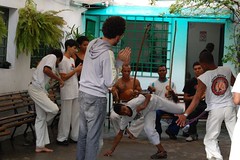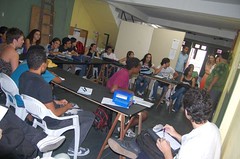- Jessica Maberry

A mural in the favela made by local residents associated with the community arts organization CEDECA in Grajau, Sao Paulo. Political and social graffiti is everywhere in Sao Paulo, and making it keeps kids out of crime.
Almost undoubtedly, Brazil is the country in the world with the greatest public investment in community arts and culture. There are dozens of groups teaching video, hip hop, graffiti, circus, carnival-related arts and digital media to youth from favelas. In Rio alone, we visited five groups doing community arts, and between these five NGOs we calculated there were around 500 kids from favelas this year alone learning video up to a semi-professional level. Coming from India, where there is very little community media (when we started, there were only two other groups in India running permanent programs in community video), this was amazing and wonderful to see. Here are some of the reasons for this, as well as our main observations, inspiring moments and facts regarding Brazil’s community media that we learned in our month visiting the different groups. I hope I’ve gotten all the facts correct, but please correct me if you see any mistakes in what I’ve written below, because much of this information is simply notes I took during fascinating discussions.
The Brazilian government is highly committed to supporting community arts and culture. There is a 3% tax break for corporations that support the arts, and this only applies to the arts! The government created a program of “points of culture” around the country, where they have invested in 150 community arts projects around the country, to the tune of R$150,000 (around $75,000) per year, for three years (this figure may be wrong). Many of the media NGos we visited were funded in this way. The singer Gilberto Gil is currently the Minister for Culture and, given that he’s one of the most revered celebrities in the country, this focuses citizens’ attention on the importance of the arts to some degree.

Capoeira in the city streets
Work of Great Production Value
It makes sense that this level of investment would be happening in Brazil and not in countries with more desperate poverty situations. One of the major societal challenges in Brazil is to keep young kids from favelas out of gangs and drugs and violence. So speaking to them in the languages they understand and love – hip hop, graffiti, video – is possibly the best strategy for reaching disaffected youth. Susan Worcman, the director of the Brazil Foundation, says this is because “artistic talent in Brazil is generally very high. We have a lot of creative people.” Driving around Sao Paulo seems to confirm this. The city is the graffiti capital of the world, with some artists from favelas having been exhibited in major museums in European capitals. All over the city, as much in the hipster area of Villa Madelaina as in the favelas, you see incredible graffiti murals. It integrates the middle classes with the favelas in some powerful ways. For instance, there was a community frescoing program in many parts of the city a few years ago, where kids from favelas worked with professional artists to create frescoes exhibited on the sides of buildings all over the city, all of which carry plaques reminding passers by leaving their expensive dinners that they were produced by slum kids.

a hip hop Sunday at Casa Das Caldeiras. Kids come en masse from all over Sao Paulo to dance and have fun, and also partake in educational activities.
The quality of community arts work is generally very high. Several of the NGO programs have been started either by famous directors (for instance, Cinema Nosso which grew out of the City of God), TV producers (Instituto Criar in Sao Paulo, which was started by a Globo Executive) or musicians (ie, Afro Reggae, started by a hip hop artist.) Therefore, lots of this community video work has been seen on TV, won awards, and one even resulted in a feature movie deal (Cine Cufa, though the project may now be on hold.) For us, we’ve put less emphasis on how artistic a community film is, and much more on how it will inspire action. But because of their quality, these Brazilian films seem to have a much higher chance of marketability in the mainstream.

Kids Learning video at Cinema Nosso
The purpose of most of the community media groups we met is to empower youth to fight the stereotypes that predominate in the Brazilian media about favelas. One great organization we visited is the urban planning organization Observatorio de Favelas. Its very name implies changing the point of reference of who is watching whom. It is the favelas observing the rest of the city, and this is a very different way of doing urban planning. They speak not of “city center” and “periphery areas” as is the usual nomenclature, but rather of areas of high and low public investment.

Photography class at Observatorio de Favelas
It is clear in five minutes in Brazil that the favelas are shown in the media almost exclusively as sites of violence and never as the culturally and creatively rich areas they are, and this creates real fear in the middle class population. The hotel receptionist begged us not to go to a certain favela area when we asked her for directions. Some cab drivers refuse to take people to certain places. The point of most of the community media we saw is to change the stereotypes of the mainstream, and to teach the kids to be critical of this media. (So there is relatively little community media/journalism being done as VV does it, where the purpose is to screen media back to communities.)
“Arts and Culture” vs. “News and Information”
Each country VV has worked on has a different outlook or way of using community media. In India – at least in our work – media is a tool to empower people to take action; it is a tool to accelerate other social change efforts. In the US, the scene is much more about news and information and how do we respond to the current crisis in journalism. In the US, investment in community arts and culture projects was much higher ten years ago than today. In other parts of South America, there is a very strong indigenous media scene that unites different tribes across North and South America. In Brazil, the focus is very definitely “community arts and culture.” It’s about community media as a right in itself, and as an educational tool. Most of the organizations we met were focused primarily on training as opposed to on the distribution of that content or its use.
Some Media Stats for Brazil
We learned some interesting media facts and policy facts from our conversation with Flavio at Ashoka, Bia Barbosa at Interv
oces, and John Prideaux the Economist correspondent in Brazil. Newspaper readership is extremely low as compared to other countries. TV is by far the dominant information source in the country, and nearly everyone watches only one channel, Globo. (We saw ourselves how media-watching habits seem much more unified here, like in 1970s America. A recent very popular “telenovela” was a drama set in India, and everyone mentioned it. People were coming up to my partner Stalin in the metro giving him a Namaste bow and repeating “arre baba.” Just one of the ways you see these two incredibly strong emerging markets coming together through globalization. 90% of the country is reached by terrestrial TV (thanks to the efforts not of the government as in other countries but of Globo), and very few (maybe less than 20%?) have cable or satellite TV. We asked Bia if there were any efforts by media activists and community media organizations to jointly create a TV channel, given that there is such a huge amount of content produced by all the community media groups. She said an impediment to this is the fact that terrestrial TV is the only option. There is literally no more bandwidth available.
All of Brazil media is controlled by six families/companies, and there are no limits on cross ownership of media or limits on how much of the audience one company can reach, as there are in other countries. This is something Bia at Intervoces is fighting for, because it means that single corporations are often dominating public opinion on one place. Other policy effort media activists are fighting for are:
- The creation of independent public TV, a la BBC, which doesn’t currently exist. There was recently created a government education channel, which does make more space for socially relevant media, but it is controlled by the government.
- The increasing of diversity on television. Bia is arguing that with so many community media groups and productions, the government should make space for this programming that truly reflects the diversity of the country;
- Liberalization of internet laws. One upcoming fight will be to allow political parties to use the internet to gain support. What Barack Obama achieved with the internet would currently be illegal in Brazil.
There is clearly much more to learn about the movements in Brazil to reform and democratize the media, and these are just our first impressions. I apologize for any errors in the above facts, and hope people will correct me.
Fighting for Change: The Story of Bihar-Based Journalist Amir Abbas
Inspiration can come from many sources, but one of the most powerful is seeing someone walk the path before you. Our Community Correspondent, Syed Amir Abbas found his inspiration in Stalin K., the founding director of Video Volunteers. “I met Stalin at VV’s national meet in 2017 and I...
Video Volunteers Receives Encouraging Response To Its Buland Bol Program
Free media training course Buland Bol aims to train hundreds of people in becoming the voice of their communities.
